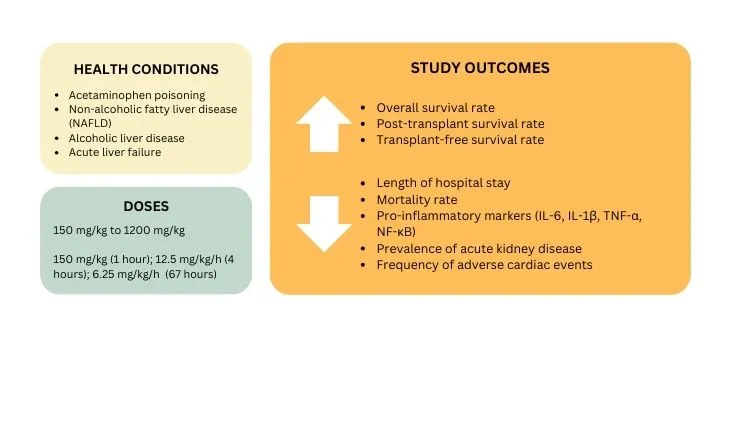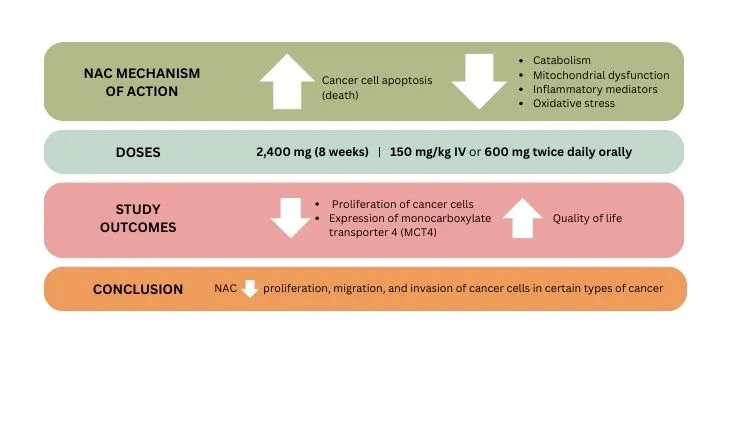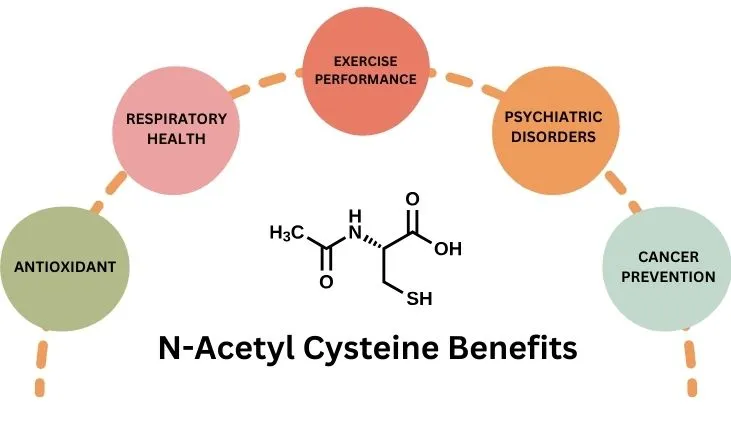N-acetyl cysteine (NAC) is a synthetic acetylated variant and precursor to the non-essential amino acid L-cysteine. Its primary role is as an antioxidant and precursor to the antioxidant glutathione. Research suggests NAC supplementation could benefit exercise performance, lung diseases, psychiatric illnesses, neurodegenerative diseases, and more due to its potent antioxidant and anti-inflammatory actions.
Quick Look
- N-acetyl cysteine is an acetylated variant and precursor to the amino acid L-cysteine.
- NAC is a powerful antioxidant and serves as the precursor to glutathione production, the body’s “master antioxidant” and most crucial biothiol.
- Research suggests NAC supplementation may benefit exercise performance through its ability to reduce exercise-induced inflammation and fatigue.
- Clinical indications of NAC supplementation include lung diseases, kidney and liver diseases, psychiatric illnesses, and more.
Table of Contents
What Is N-Acetyl Cysteine?
N-acetyl cysteine, commonly shortened to NAC, is an acetylated variant and precursor to L-cysteine. To understand the functions of NAC, let’s take a quick look at L-cysteine.
L-cysteine is a nonessential amino acid naturally synthesized in small amounts in the human body under normal circumstances. However, during specific physiological periods of growth, including pregnancy, adolescent growth, or recovery from trauma, cysteine becomes “conditionally essential” and cannot be synthesized de novo in sufficient quantities.
Cysteine is synthesized from the amino acid methionine in four steps:
Methionine → homocysteine→ (serine) → cystathionine → cysteine + acetate + NH3
Cysteine is synthesized from the amino acid methionine via the de novo transsulfuration (TSS) pathway. It can also be salvaged from glutathione, taken up in its reduced form from extracellular sources, or obtained via protein catabolism.
So, what’s the difference between NAC and cysteine? The two amino acids share the same basic structure, but NAC adds an acetyl group—hence the name acetylcysteine—to enhance bioavailability.
What Does N-Acetyl Cysteine Do?

N-acetylcysteine is a drug initially used for the treatment of acetaminophen overdose (paracetamol) but more recently as a mucolytic agent to improve various respiratory disease symptoms. It has a well-established safety profile and minimal toxicity (administration route and dosage-dependent).
The amino acid offers powerful antioxidant and anti-inflammatory properties, making it helpful in treating many diseases associated with oxidative stress and inflammation. The primary role of NAC as an antioxidant is derived from its ability to increase the intracellular concentration of glutathione (GSH), the body’s “master antioxidant” and most important biothiol responsible for cellular redox imbalance. As an anti-inflammatory agent, NAC can reduce levels of specific inflammatory markers, such as tumor necrosis factor-alpha (TNF-α) and interleukins (IL-6 and IL-1β), by suppressing the activity of nuclear factor kappa B (NF-κB).
After oral consumption, NAC is rapidly absorbed in the intestine and metabolized in the liver, where most of the cysteine is released toward GSH synthesis. It reaches maximum plasma concentration between 1 and 2 hours after consumption.
N-Acetyl Cysteine Benefits and Uses
N-acetyl cysteine supplements offer a lot of health benefits for many conditions. Here’s a breakdown of the available research and what it has to say about the efficacy of NAC.
Exercise Performance
N-acetyl cysteine can be used as a sports supplement for its ability to modulate exercise-induced oxidative damage via its antioxidant properties and ability to maintain GSH homeostasis, potentially leading to improved exercise performance.
High-intensity or strenuous exercise increases the generation of reactive oxygen species, which can adversely affect health and performance if not addressed. Excessive free radical production can lead to cell damage at the level of the myocyte membrane or result in an exacerbated inflammatory response, leading to excessive pain, premature fatigue, and injury.
Research suggests that NAC can modulate oxidative stress by acting as a cysteine donor to maintain GSH homeostasis and acting as an antioxidant to directly reduce reactive oxygen species (ROS). NAC can improve exercise performance through the following actions:
- Reducing exercise-induced inflammation and fatigue through its thiol content
- Upregulating anti-inflammatory cytokines
- Minimizing skeletal muscle damage after exhaustion of contractile activity
Here’s what the research says.

- A 2023 systematic review and meta-analysis of studies investigating the effects of NAC supplementation on physical performance and lab biomarkers concluded that participants using NAC supplements showed significant improvements in exercise performance, antioxidant capacity, and GSH homeostasis. Still, there was little evidence to suggest NAC could benefit hematological markers, inflammatory response, and muscle behavior.
- A 2017 study examined whether NAC supplementation would improve exercise performance by increasing GSH levels and reducing oxidative stress in people with low resting GSH levels. Results showed improvements in VO2max, time trial, and Wingate by 13.6%, 15.4%, and 11.4%, respectively, in the group with low GSH. Thirty days of NAC supplementation were also enough to restore baseline GSH levels, reduce systemic oxidative stress, and improve erythrocyte GSH metabolism in the same group. However, the 30-day supplementation period did not offer benefits on performance and redox state of the group with moderate and high GSH levels.
- A 2004 study looked at the effects of NAC supplementation on muscle cysteine, cystine, and GSH and on time to fatigue during prolonged, submaximal exercise in endurance athletes. Endurance athletes were given 125 mg/kg per hour for the first 15 minutes and 25 mg/kg for 20 minutes before and throughout cycling activity. Researchers concluded that NAC supplementation improved performance in well-trained individuals, likely through enhancing muscle cysteine and GSH availability.
However, a 2017 systematic review and meta-analysis looked at studies investigating the effects of NAC supplementation on exercise performance and/or side effects. Results showed a mean NAC dosage of 5.8 grams/day with a total range between 1.2 and 20 grams/day and a mean performance increase of just 0.29%. Researchers concluded that despite research suggesting NAC benefits exercise performance, they cannot recommend further supplementation.
Research on the effects of NAC supplementation on exercise performance tends to show benefits, but more research is needed to offer a conclusive opinion.
Clinical Indications
Lung Diseases
Action: Antioxidant, anti-inflammatory, mucolytic
Recommended dose: 600-1,200 mg up to 3 times per day

Several respiratory diseases are characterized by inflammation and oxidative stress combined with low endogenous antioxidant levels, especially GSH. NAC offers potential as a therapeutic agent for several respiratory diseases, including:
- Chronic obstructive pulmonary disease (COPD)
- Cystic fibrosis (CF)
- Idiopathic pulmonary fibrosis (IPF)
Keep reading below for a breakdown of the NAC dosages and outcomes from five research studies.

- A 2013 randomized control trial found that high-dose NAC (600 mg oral twice daily) significantly improved small airway function in subjects with stable COPD. They also experienced a reduction in the frequency of exacerbation of the disease.
- A 2014 randomized control trial using 1006 patients with moderate to severe COPD found that 1,200 mg oral NAC daily (2-600 mg doses) led to a significant reduction in acute exacerbations.
- A 2015 meta-analysis found that prolonged treatment with high doses of NAC (≥1200 mg/day) could prevent exacerbations of COPD. Still, lower doses of NAC (600 mg/day) may only be effective for patients with chronic bronchitis without COPD and airway obstruction.
- A 2012 clinical trial on the effectiveness of inhaled NAC for mild to moderate IPF showed minimal differences in outcomes for forced vital capacity (FVC), arterial oxygen saturation, six minutes walking distance test (6MWD), pulmonary function between patients who took NAC and those who took a placebo. However, they did demonstrate NAC supplementation was well-tolerated.
But it’s not all good news for NAC and respiratory function. Some research suggests that NAC supplements offer little benefit. A 2016 study found that high-dose NAC (1800 mg twice a day for 3,600 mg/day) was well-tolerated but did not elicit positive effects on general respiratory health, lung function, or circulating measures of systemic oxidative stress and inflammation.
Cardiovascular Diseases
Action: Antioxidant, anti-inflammatory
Recommended dose: 20 mg/min for the first hour and 10 mg/min after
Oxidative stress is an underlying factor involved in the development and progression of cardiovascular disease (CVD). Studies have shown NAC elicits cardioprotective properties for several conditions, including:
- Diabetic cardiomyopathy (DCM)
- Acute myocardial infarction (AMI)
- Heart failure (HF)
- Coronary artery disease (CAD)
We looked at the research on NAC and cardiovascular diseases, and here are the outcomes from three studies.

- The multicenter clinical trial NACIAM (N-acetylcysteine in acute myocardial infarction) found that combined treatment of high-dose IV NAC (29 grams over 2 days) combined with a low dose of nitroglycerin (7.2 mg over 2 days) was effective for reducing the size of acute infarction in patients with ST-segment elevated myocardial infarction (STEMI) undergoing primary percutaneous coronary intervention. Researchers also found NAC administration improved myocardial rescue and elicited faster resolution of chest pain.
- An older study published in 1995 found that combined treatment of 15,000 mg of IV NAC over 24 hours combined with nitroglycerin and streptokinase reduced oxidative stress in subjects with AMI, as demonstrated by higher levels of reduced and oxidized GSH. Patients received 5 μg/min of nitroglycerin before starting the clinical trial and then received an IV infusion of 20 mg/min in the first hour, followed by 10 mg/min in the following 23 hours for a total dose of 15,000 mg over 24 hours. After the infusion, patients were given 100 mg of hydrocortisone, followed by 1.5 MU of IV streptokinase for 30 minutes.
- A 2004 clinical trial found that 50 mg/kg of IV NAC for three days in patients undergoing coronary artery bypass grafting (CABG) led to decreased pump-induced oxidoinflammatory response during the procedure, suggesting NAC may offer benefits for preventing CBP-induced oxidoinflammatory damage.

However, not all research suggests benefits. A systematic review with 29 clinical trials and 2486 participants looking at various NAC administration routes (IV, oral, oral plus IV) and doses (<100, 100 to <300, ≥300 mg/kg/day) found that supplementation did not significantly reduce adverse outcomes associated with cardiac surgery, including mortality, acute renal failure, heart failure, length of stay and/or ICU, arrhythmia, and acute myocardial infarction.
Psychiatric Disorders
Action: Anti-inflammatory, antioxidant
Recommended dose: 600 to 3,600 mg/day
Due to its anti-inflammatory properties, NAC has been recognized as a possible therapeutic agent for treating several psychiatric illnesses, including:
- Compulsive disorders
- Schizophrenia
- Bipolar disorder (BD)
- Depression
Some research suggests the etiology and progression of psychiatric illnesses involve the deterioration of cerebral energy metabolism, mitochondrial dysfunction, and redox imbalance, all of which are linked to environmental and genetic factors. So, how does NAC fit into the picture?
Here’s a breakdown of three studies.

- A 2018 randomized control trial looked at the safety and efficacy of 2,000 mg of NAC combined with conventional antipsychotic medications in patients with schizophrenia. Supplementation showed positive results for specific cognitive functions, such as attention, short-term and working memory, executive functioning, and processing speed.
- A 2020 meta-analysis found that 600 to 3,600 mg NAC administration for a minimum of 24 weeks could improve symptoms of schizophrenia, specifically cognitive function. Improvements may result from a combination of lower oxidative stress, neuroprotection of cognitive networks, and an increase in glutamatergic modulation of the NMDA receptor system.
- A 2014 study found that NAC supplementation may improve symptoms of major depressive disorder (MDD) via altering specific pathways involved in MDD pathogenesis, specifically the oxidative and inflammatory stress and glutamate pathways.
That said, more research on the benefits of NAC for psychiatric illness and mood disorders is needed, as most studies provide inconclusive results. For example, a 2019 study failed to find any significant effects with 2,000 mg/day of NAC alone or combined with other antioxidants in subjects with bipolar disorder and depressive symptoms.
Neurodegenerative Diseases
Action: Antioxidant, neuroprotective
Recommended dose: 6,000 mg/day
NAC can cross the blood-brain barrier, boost GSH levels, reduce inflammation, and modulate various neurotransmitter systems. It’s also been shown to modulate NMDA receptors, which, when modified, can elicit neurological and psychiatric changes.
Neurodegenerative diseases are complex and have several pathologies, but the majority of research points to the role of oxidative damage, GSH depletion, and/or NMDA receptor dysfunction as primary contributors. NAC’s ability to boost intracellular GSH levels and reduce oxidative stress presents an alternative therapy to prevent or minimize the progression of neurodegenerative diseases.
Let’s see what the research says about how NAC could affect neurodegenerative diseases, the dosages used for various studies, and the outcomes of those studies.

- A 2013 study using a single IV dose of NAC at 150 mg/kg found an increase in blood GSH/GSSG and cerebral GSH ratio in people with Parkinson’s disease.
- A 2019 randomized control trial found that IV doses of NAC at 50 mg/kg or oral doses of 500 mg twice daily for three months positively affected the patients’ dopaminergic system, improving clinical effects.
- A 2015 study looked at the effects of a nutraceutical formula containing folate, alpha-tocopherol, B12, S-adenosyl methionine (SAM), NAC, and acetyl-L-carnitine on patients with cognitive impairment. The group taking the nutraceutical formula with 600mg of NAC for six months saw improvements in the Dementia Rating Scale, while those taking the placebo did not.
- A 2020 study investigated the effects of an NAC supplement on cerebral glucose metabolism and symptoms in patients with multiple sclerosis (MS). Patients were given IV doses of up to 50 mg/kg (once a week) and oral doses of up to 1,000 mg/day (6 times a week), and results showed improvements in cerebral glucose metabolism, cognition, and attention.
As with other studies, not all ended in positive results. A 2021 study found that MS patients supplementing with 1,250 mg of NAC saw no significant improvements in fatigue or GSH levels.
Liver and Kidney Diseases
Action: Antioxidant, anti-inflammatory
Recommended dose: N/A
Oxidative stress is an important factor underlying the development of acute and chronic liver diseases, playing a role in the liver’s fibrogenic response and stimulating its progression. NAC’s antioxidant and anti-inflammatory properties may help reduce liver damage by modulating inflammation and oxidative stress.
NAC is widely used in acetaminophen poisoning, but it’s also recognized as a therapeutic agent in other diseases, such as:
- Non-alcoholic fatty liver disease (NAFLD)
- Alcoholic liver disease
- Acute liver failure
We looked at several studies, and here’s a breakdown of which health conditions NAC was used to treat, the average doses, and study outcomes.

- A 2021 meta-analysis on the effects of NAC for non-acetaminophen-related acute liver failure found that NAC supplementation significantly improved overall survival, post-transplant survival, and transplant-free survival while reducing the overall length of hospital stay.
- A similar study published in 2017 found that IV administration of NAC at 150 mg/kg over 1 hour, followed by 12.5 mg/kg/h for 4 hours and continuous infusion of 6.25 mg/kg/h for the remaining 67 hours for people with non-acetaminophen-related acute liver failure resulted in decreased mortality, reduced hospital stay, and higher survival rate.
- Experimental studies on the effects of NAD for people with NAFLD found that NAC administration can block the accumulation of liver lipids and reduce proinflammatory markers, such as IL-6 and IL-1β, TNF-α, and NF-κB.
Some research also suggests positive outcomes for individuals with kidney disease.
- A 2018 meta-analysis demonstrated that administration of NAC in doses ranging from 150 mg/kg to 1200 mg/kg in patients with kidney disease undergoing cardiac surgery led to significant reductions in the prevalence of acute kidney injury and adverse cardiac events.
Cancer
Action: Anti-inflammatory, antioxidant
Recommended dose: 1,200-2,400 mg/day
NAC possesses important pharmacological and biological activities that offer potential as a therapeutic agent in preventing and treating certain types of cancer. As such, it’s been researched for its ability to reduce cancer hostility, increase cancer cell apoptosis, and reduce catabolism, mitochondrial dysfunction, inflammatory mediators, and oxidative stress levels.
We looked at two studies on the effects of NAC on cancer, and here’s what we found for its mechanism of action, dosages, and study outcomes.

- A 2021 study on the effects of NAC supplementation in patients with head and neck cancer found that 2,400 mg of liquid NACtaken daily for eight weeks from the start of radiation therapy led to improvements in quality of life without any side effects or discomfort.
- A 2017 pilot study looked at NAC supplementation in people with stage 0 and 1 breast cancer. Patients were administered IV NAC once a week at 150 mg/kg and 600 mg twice daily orally on the days not receiving IV NAC. Results showed that NAC was well tolerated and reduced the proliferation of cancer cells and the expression of monocarboxylate transporter 4 (MCT4), a marker of glycolysis in breast cancer.
Research on the benefits of NAC for cancer treatment and prevention is still in the early stages. Still, based on current evidence, NAC supplements may reduce the proliferation, migration, and invasion of cancer cells in certain types of cancer.
Other Conditions
Research suggests NAC supplementation may also offer benefits for other conditions, including:
- Sickle cell anemia
- Male infertility
- Autism spectrum disorder (ASD)
- Pre-eclampsia
- Gestational diabetes
- Metabolic syndrome
- Ocular conditions
N-Acetyl Cysteine Supplements
If you’re considering taking an NAC supplement, there are several kinds available:
- NAC aerosol spray: Used for treating respiratory conditions or pulmonary disease. Note: A prescription is required for this form.
- Cysteine/NAC tablets or capsules: NAC capsules and tablets are frequently used to prevent and sustain antioxidant defenses and overall health and well-being.
- For maintenance: 500-600 mg per day
- For respiratory illness: 200–600 mg, twice daily
- For COPD: 600 mg, twice daily (some studies suggest up to 2,800 mg per day for up to 3 months)
- NAC liquid solution
- NAC topical solution
- L-cysteine amino acid powder
N-Acetyl Cysteine Daily Intake Recommendations
There’s no optimal dosage for NAC, as the appropriate dosage largely depends on the individual and the condition being treated. However, most experts recommend around 500-600 mg/day to maintain good health and well-being.
NAC can be taken any time during the day and generally comes in 500-, 600-, 750- and 1,000-mg tablets. Depending on the dosage, you may need to divide it for better results.
NAC Safety and Side Effects
Amino acid side effects aren’t always common, but they do happen. That’s why it’s important to know what to look out for. Some side effects of taking NAC supplements include:
- Anaphylactoid reactions
- Rash
- Hypotension
- Wheezing and/or shortness of breath
- Anaphylactoid reactions in people with asthma
- Skin rash, hives, itching, acute flushing, and skin redness after IV administration
- Chest tightness and bronchoconstriction
- Bronchospasm
- Increased airway obstruction after oral inhalation
- Nausea and vomiting after oral administration of NAC supplements
N-Acetyl Cysteine Drug Interactions
NAC can interact with certain drugs or medications. Practice caution if taking any of the following:
- NAC can reduce the excretion of certain drugs, including pravastatin, valsartan, erythromycin, torasemide, lovastatin, liothyronine, digoxin, cerivastatin, raloxifene, caspofungin, enalapril, simvastatin, and penicillamine.
- Eluxadoline (NAC can increase serum concentrations)
- Oxytetracycline, trypsin, or tetracycline can decrease NAC efficacy.
People taking certain medications should avoid taking NAC supplements:
- Nitroglycerin
- Activated charcoal
- Chloroquine (Aralen)
- Antihypertensive drugs
- Anticoagulants/antiplatelet drugs
Frequently Asked Questions
Is NAC the same as L-cysteine?
L-cysteine is an amino acid naturally found in foods and the body, while NAC is a synthetic variant and precursor to L-cysteine that adds an acetyl group for enhanced bioavailability. L-cysteine and NAC both offer similar benefits, but their structures differ.
Is N-acetyl cysteine safe?
Yes, NAC is well-tolerated by most healthy adults. Studies show that NAC dosages of up to 3,000 mg/day in respiratory diseases are safe and well-tolerated. For maintenance of health and well-being, the average dose is around 500-600 mg/day.
What is N-acetyl cysteine good for?
Thanks to its antioxidant, anti-inflammatory, and mucolytic properties, NAC has been used as a treatment for several conditions and diseases, including PCOS, preterm birth, acetaminophen toxicity, RPL, chronic bronchitis, ulcerative colitis, liver cancer, muscle performance, hemodialysis, asthma, and Alzheimer’s and Parkinson’s disease.
Can NAC affect female hormones?
Research suggests that NAC supplementation can decrease total testosterone levels and increase FSH levels. For people with PCOS, N-acetyl cysteine supplements have been shown to be effective in improving reproductive system function.














